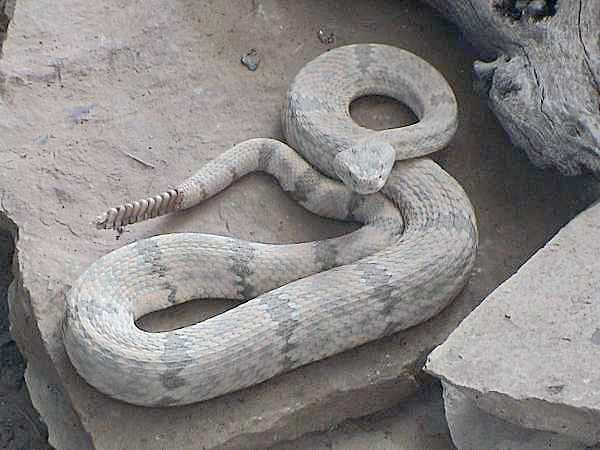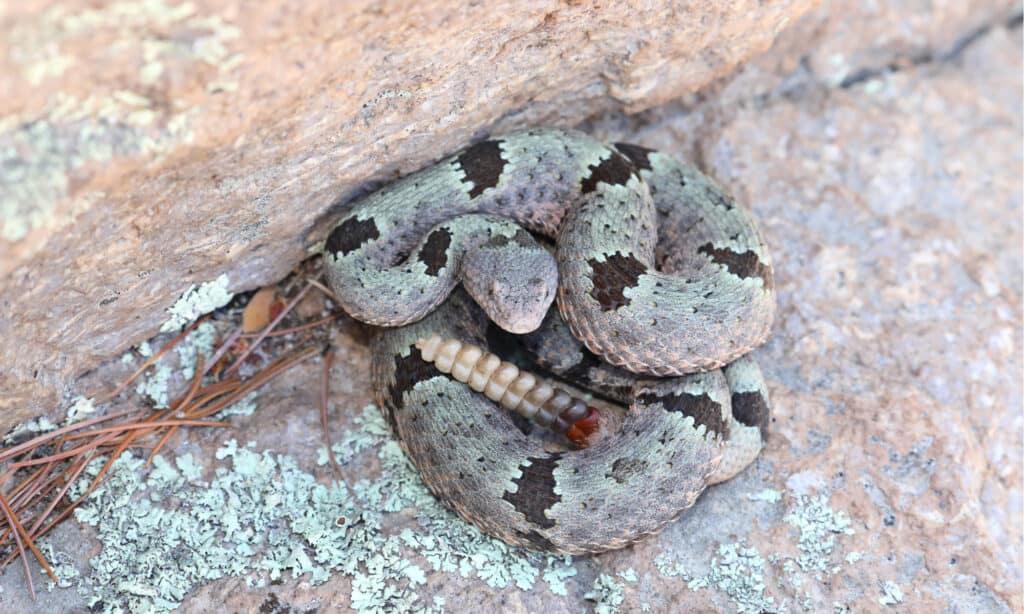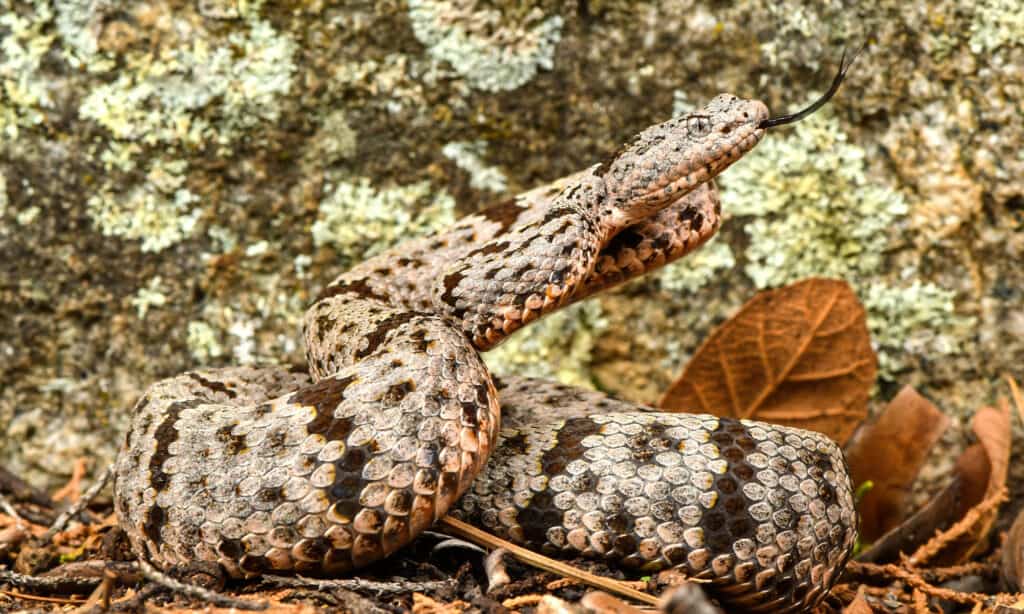What Are Rock Rattlesnakes?
Rock rattlesnakes are any of four different venomous rattlesnakes in the Crotalus genus. One is the monotypic Tamaulipan rock rattlesnake (C. morulus), elevated to full species status in 2016. The other three are subspecies of Crotalus lepidus.
Although you might be tempted to believe that you have found a baby rattlesnake, it may be an adult — these are small rattlesnakes and typically grow between 18 and 31 inches long. Their overall color pattern varies according to which species or subspecies, and their location. As a result, they blend almost seamlessly into their rocky habitat.
Where Do Rock Rattlesnakes Live?
These snakes live in rocky outcrops and grassy areas where they have lots of hiding places. They’re known for living in arid, rocky habitats from southeastern Arizona to southwestern Texas, and south from there into the Mexican states of Jalisco, Chihuahua, Durango, Sinaloa, Nayarit, Jalisco, and Tamaulipas.
They’re named for the rocky hillsides and talus slopes where they live, but their favorite hangouts are manmade trails and cuts into the hillside. Rock rattlesnakes love little crevices where they can wait for prey to wander close enough.
Diet and Behavior
Rock rattlesnakes seem more diurnal in their habits — that is, they are more active during the daylight hours. However, as with all snakes, their behavior can and does change according to the weather. Young rattlesnakes use their yellowish tail to lure prey to them, while adults generally employ the sit-and-wait approach to life. This makes sense because young snakes need to eat much more frequently than adults. So, they use every possible tool in the arsenal.
Rock rattlesnakes’ diet seems to vary according to where they live and what is available — primarily mice, lizards, birds, and insects. Some eat a diet that mostly consists of lizards, while others really love a centipede.
A couple of interesting things are:
- The Tamaulipan rock rattlesnake (C. morulus) has venom that seems highly effective against centipedes — and less effective against small rodents.
- A typical banded rock rattlesnake (C. l. klauberi) diet consists of approximately 55% lizards, 28% centipedes, 13% mammals, with a smattering of other species.
A non-threatening species, rock rattlesnakes only rarely bite. Rock rattlesnakes often don’t strike or even rattle unless someone directly harasses them. They try very hard to avoid people and are pretty hard to spot — their camouflage is spot-on!
Because of their generally calm nature, some people keep them as pets. However, most of those in captivity were wild-caught, not captive-bred.
Rock Rattlesnake Venom
As a small rattlesnake, these snakes do not have the same capacity for injecting venom the way an eastern diamondback rattlesnake does. Generally speaking, their venom is relatively mild and more specialized for their preferred prey, which varies according to what is available in their area.
Although they cannot inject large amounts of venom, their venom is medically significant. A bit from a rock rattlesnake of any type should be treated as an emergency.

Mottled rock rattlesnakes are usually darker overall but, like this one, can be pale.
©Dawson / CC BY-SA 2.5 – License
How to Identify Rock Rattlesnakes
One thing most rock rattlesnakes share is their pattern of dark crossbands over a gray-to-greenish color. What makes each different is how the pattern is expressed from one species or subspecies to another.
Rock rattlesnakes are small, and most are only about two feet long, but a few get a little longer. Although they are rattlesnakes and have rattles, those rattles are small and hard to hear.
Banded Rock Rattlesnake (Crotalus lepidus klauberi) — Inhabits southeastern Arizona, southern New Mexico, a tiny corner of west Texas, and south to Jalisco, Mexico. Their markings are dark, distinct, and spread widely apart. The spaces between their crossbands are relatively spot-free and clean-looking. Females usually have a bluish-gray base color, males greenish or bluish-green.
Mottled Rock Rattlesnake (Crotalus lepidus lepidus) — Lives in the southern mountains of New Mexico, west Texas, and Chihuahua, Mexico. Usually darker overall, but can sometimes be very pale. Their markings often fade toward the tail, and the space between crossbands is usually heavily spotted. Sometimes the between-crossband markings connect to form smaller bands between the primary crossbands.
Durango Rock Rattlesnake (Crotalus lepidus maculosus) — Only in Mexico, this subspecies inhabits the states of Durango, Sinaloa, Nayarit, and Jalisco. This rock rattlesnake’s markings are the exception to the rule — they are more oval-shaped than banded and usually have noticeable spotting between markings.
Tamaulipan Rock Rattlesnake (Crotalus morulus) — 2016 elevated to full species. Occurs in the Sierra Madre Oriental range in Mexico. Their markings don’t usually go as far around the body as other species, and they are highly variable. Tamaulipan rock rattlesnakes also have a dark stripe behind their eyes.
Here are a few identification tips that will help with all North American snakes, not just rock rattlesnakes.

Banded rock rattlesnakes have dark, distinct crossbands with little spotting in between them.
©Glenn McCrea/Shutterstock.com
Location
Part of the identification process involves knowing the location, so be aware! Any expert you approach will ask where you saw it before they ask anything else. Take note of where you spotted the snake — a GPS tag is nice, but the general area is usually all you need.
Here is a great example of this idea: A hiker saw a snake in Oregon, panicked because it had black and red bands, called it a coral snake and killed it. Well, coral snakes don’t live in Oregon, so it couldn’t have been a coral snake — location matters!
Head Style and Pupil Shape
Although pupil or head shape alone cannot determine what species you saw, or even whether it was venomous, together they help narrow down the options. Most North American snakes have somewhat triangular heads. However, not all snakes have noticeably large triangular heads — if you can clearly see where the head ends and the neck begins, take in a few more details.
If you think it is a rattlesnake, take a look right above its eyes — rattlers and other pit vipers have a large supraocular (above the eye) scale that makes them look like somebody stole their lunch money. That supraocular scale should be enough to make you back off a little.
Now for the pupil shape. Assuming it is a bright enough day, does that snake also have elliptical pupils? If so, you might be looking at a pit viper. You might also be too close, but we all make choices, right?
Color and Pattern
As with all other identification methods and tips, color and pattern alone do not determine anything. They narrow it down.
Take the color — is it gray or greenish-gray, maybe even brown with dark crossbands? It could be a rock rattlesnake. However, exceptions exist. People have found a few patternless western diamondback rattlesnakes and other species in the wild over the years.
Body Type and Scales
As most pit vipers look stout for their size, body type can also be used to narrow down your search. Rock rattlesnakes have stout bodies and narrow necks, so that helps rule out other species.
Their scales are also important. All rattlesnakes have keeled scales that make them look rough, like sandpaper. Of course, other snakes have keeled scales too, so that in itself is not enough for a positive ID. One additional scale feature is those in the Crotalus genus, like rock rattlesnakes, also have tiny little scales all over their heads that look sort of pebbled.
Does it Have a Rattle?
This is sort of a no-brainer with rattlesnakes — or is it? Maybe not, and here’s why:
Very young rattlesnakes that have not shed their skin enough times do not have rattles. Yet. They do, however, have a noticeable “button” at the tip of their tail. That tail button is where their rattle develops after they shed their skin a few times.
Even adult rattlers can be without a rattle sometimes. Their fancy keratin-based tail bling is brittle. Rock rattlesnakes live amongst rock crevices and outcrops, making it easier to catch on something and break. Additionally, rock rattlesnakes, in general, have smaller rattles than other species.
Rock Rattlesnake Babies and Reproduction
Every spring when they come out of brumation, the reptile form of hibernation, rock rattlesnakes go into feeding and breeding mode. Every snake is looking for its first meal of the season, and every male is looking for a female.
After mating, the females carry the babies for about four months before giving birth to up to eight young rattlesnakes. They often look like miniature versions of their parents and take several years to mature. Like some rattlesnake species, rock rattlesnake mothers stay with their young until after they have shed for the first time — usually nine to 11 days.

Rock rattlesnakes are beautiful, with markings that can vary greatly from one individual to the next.
©Jon Bolton/Shutterstock.com
The photo featured at the top of this post is © Glenn McCrea/Shutterstock.com
Thank you for reading! Have some feedback for us? Contact the AZ Animals editorial team.






